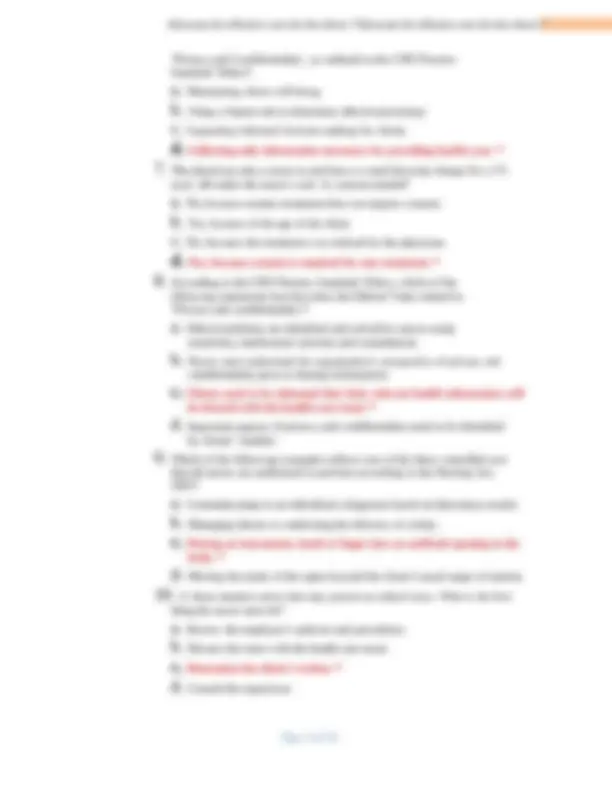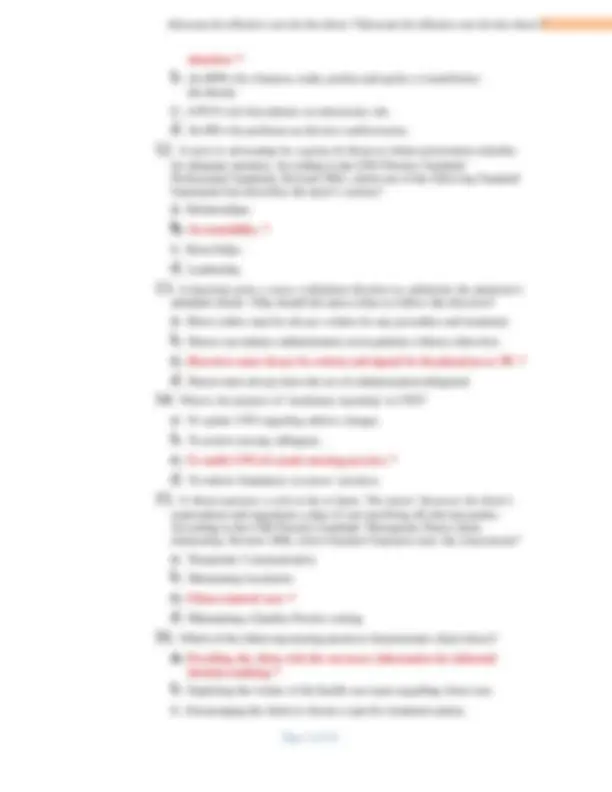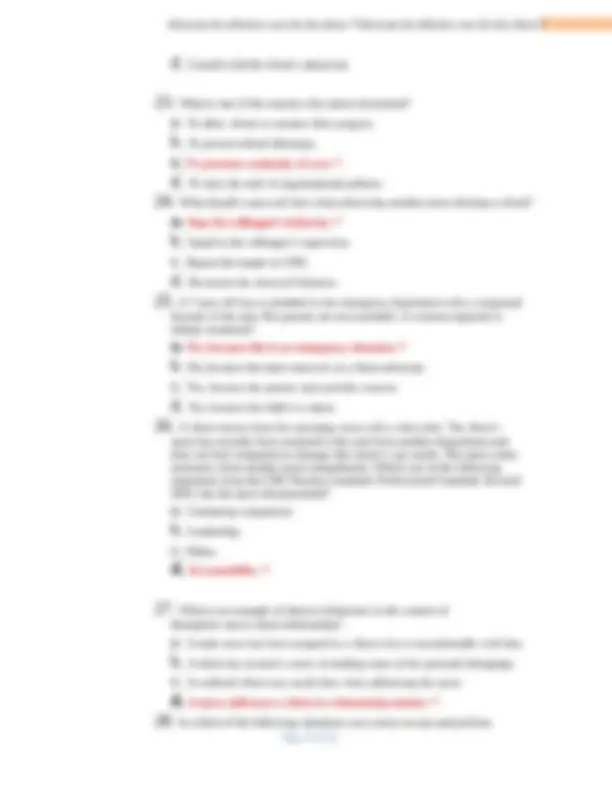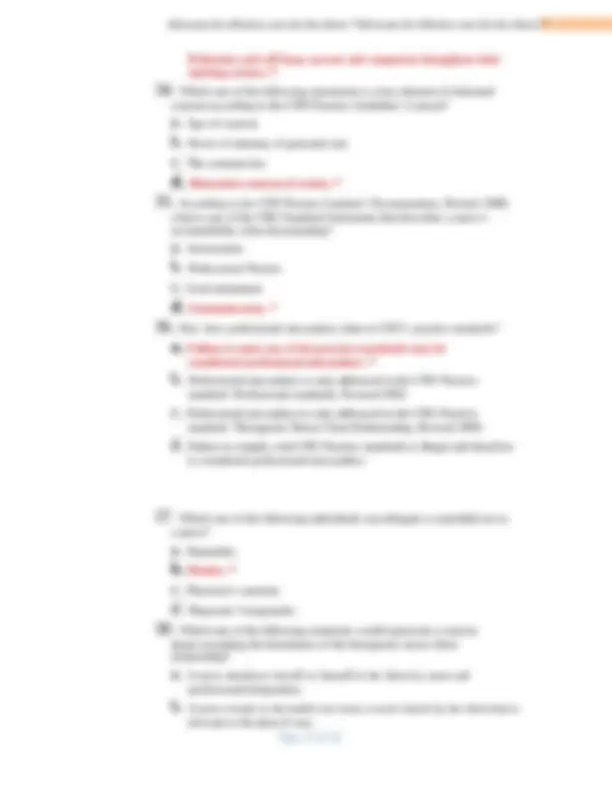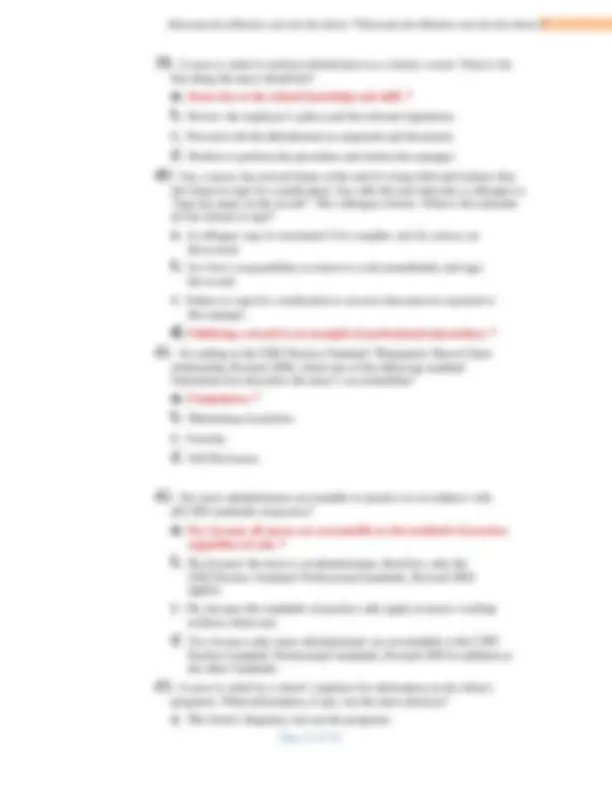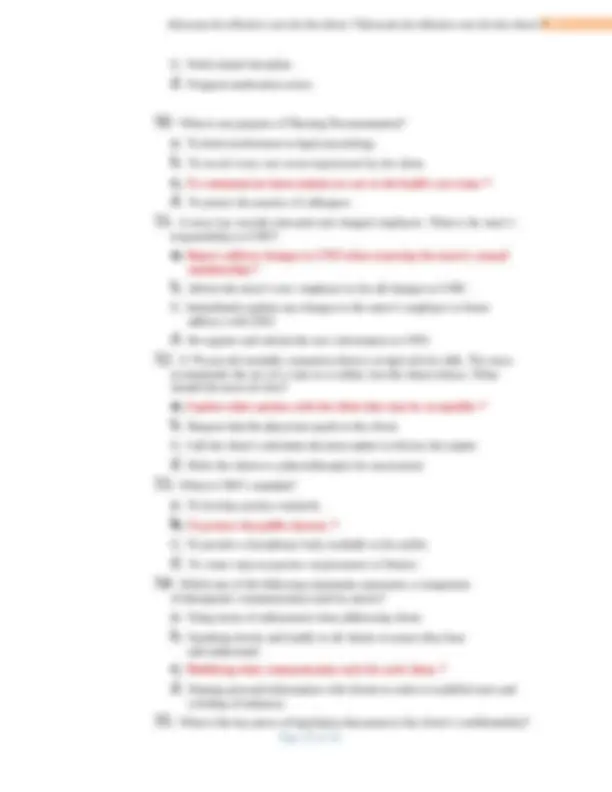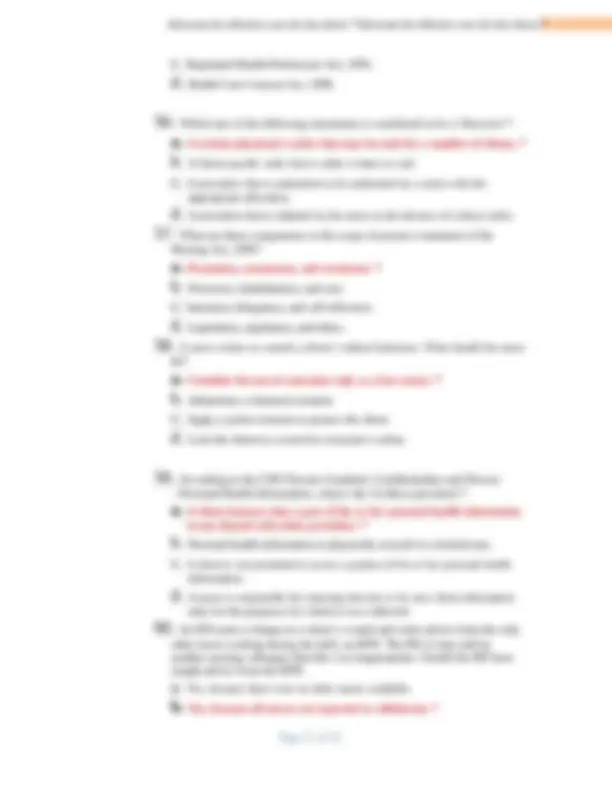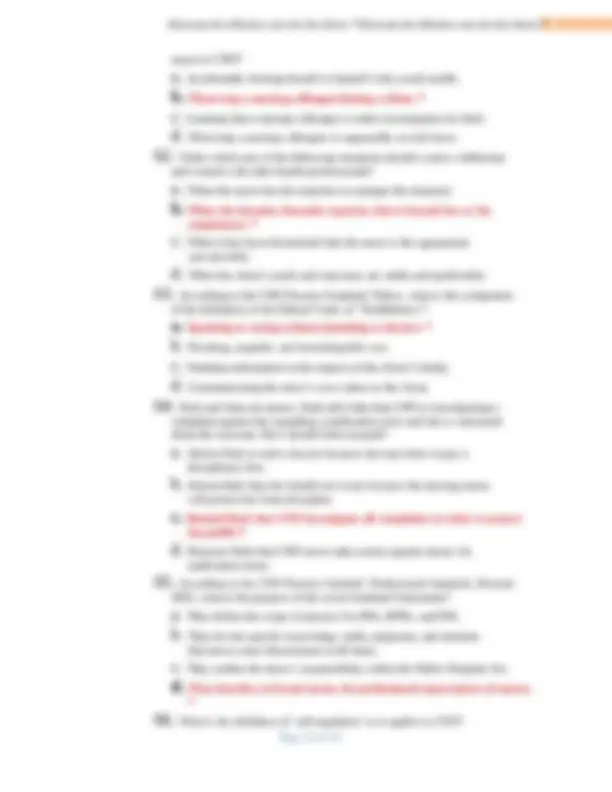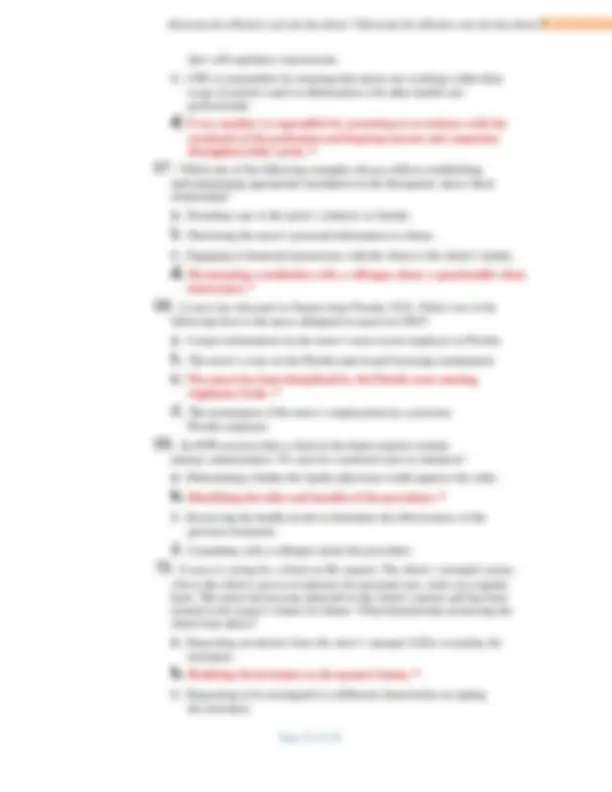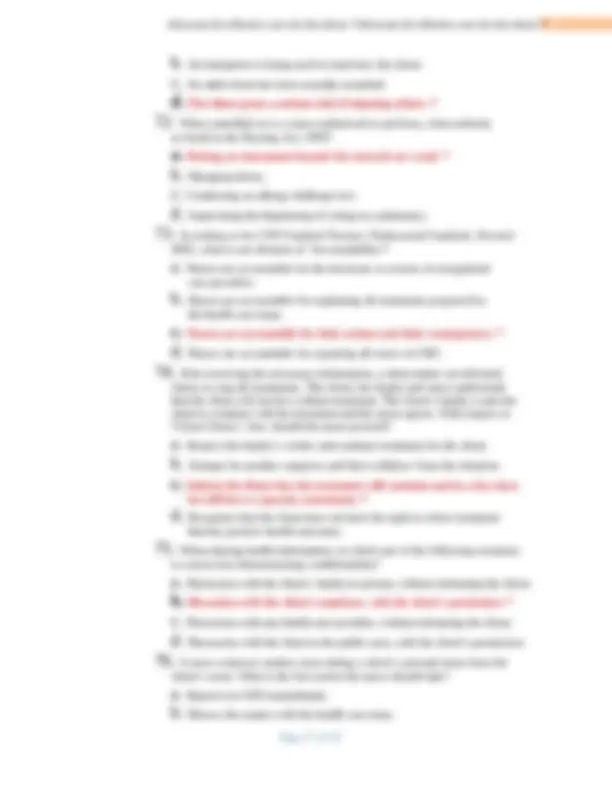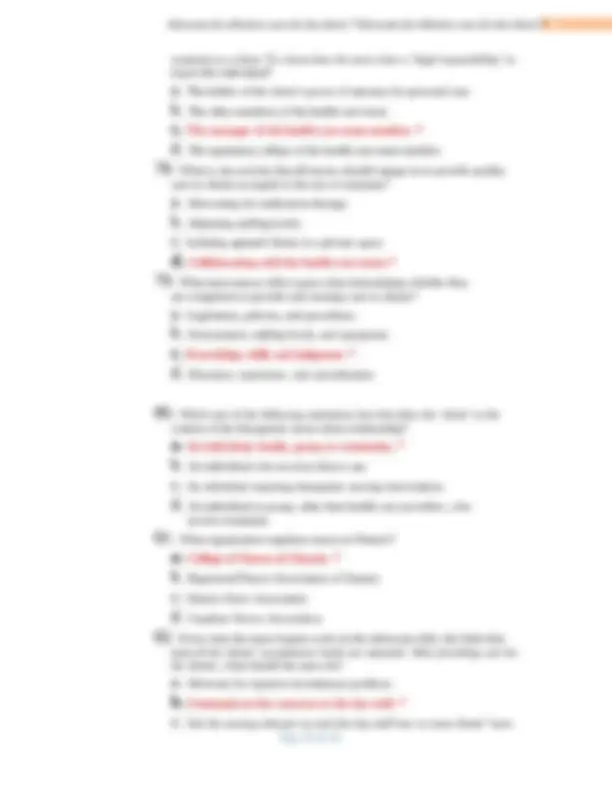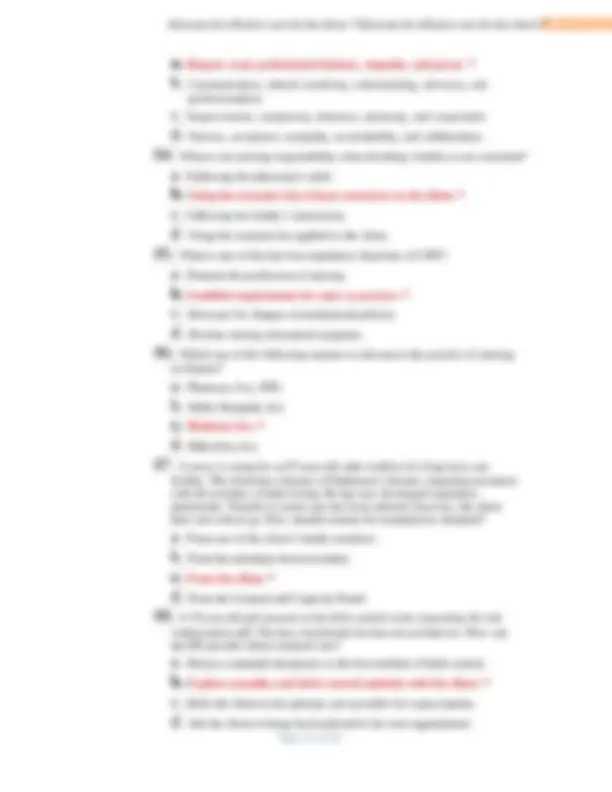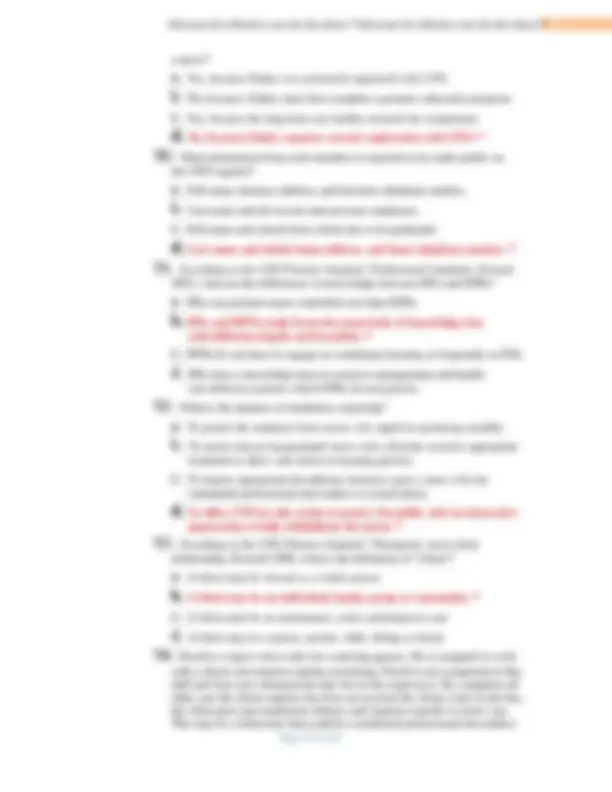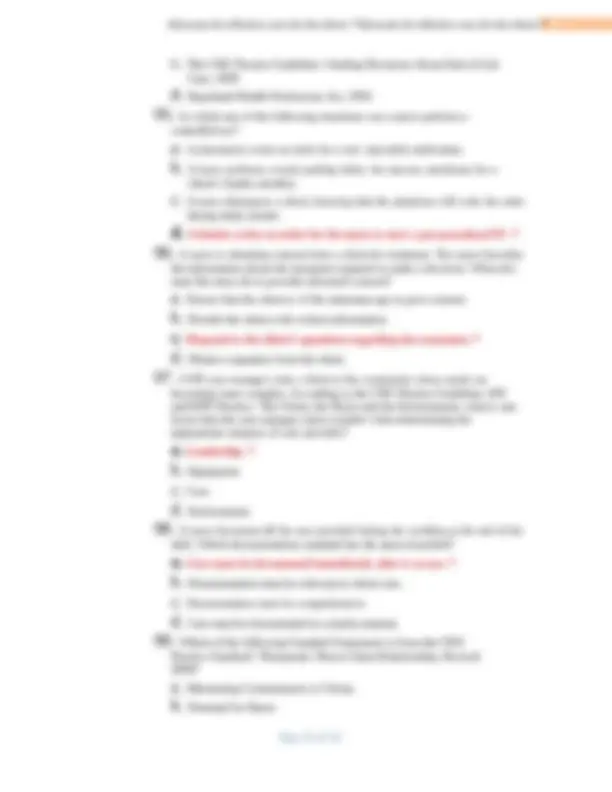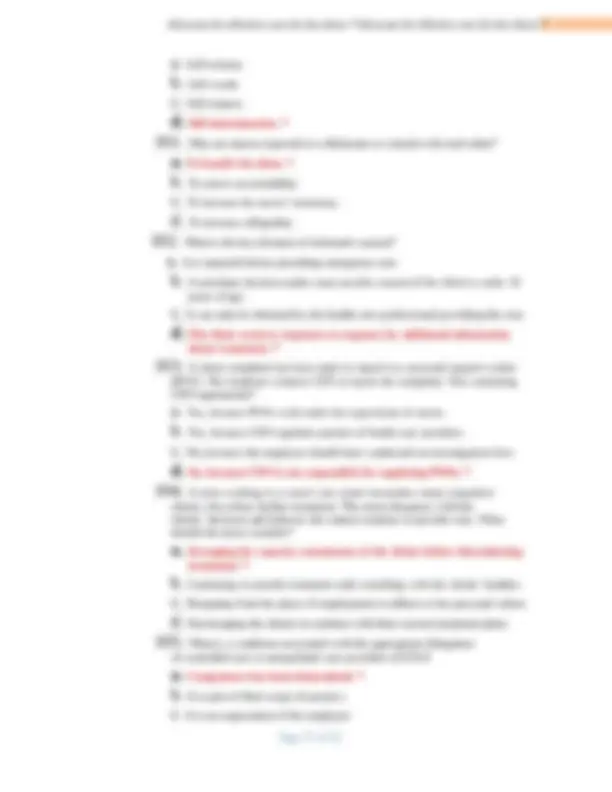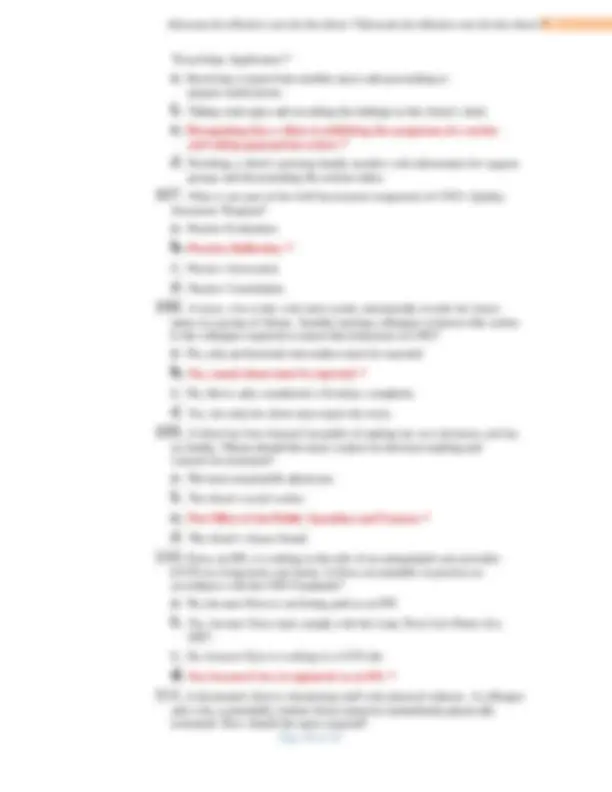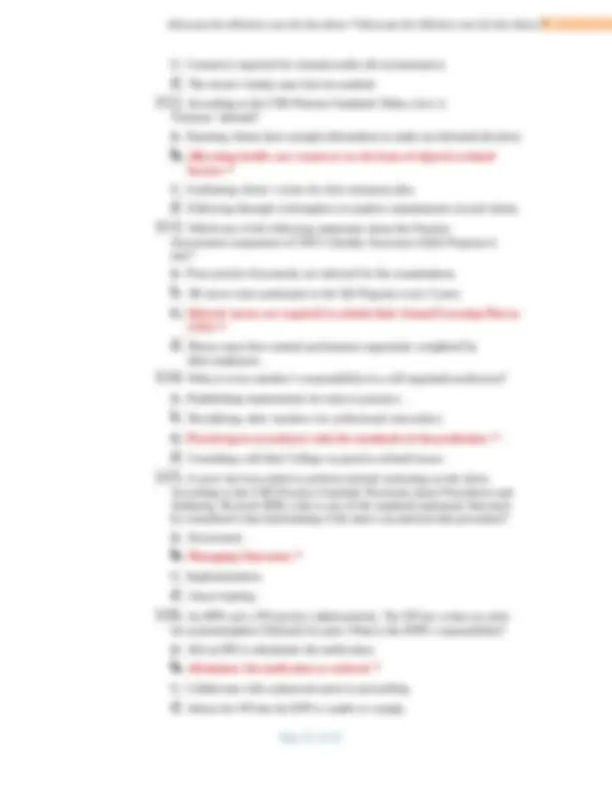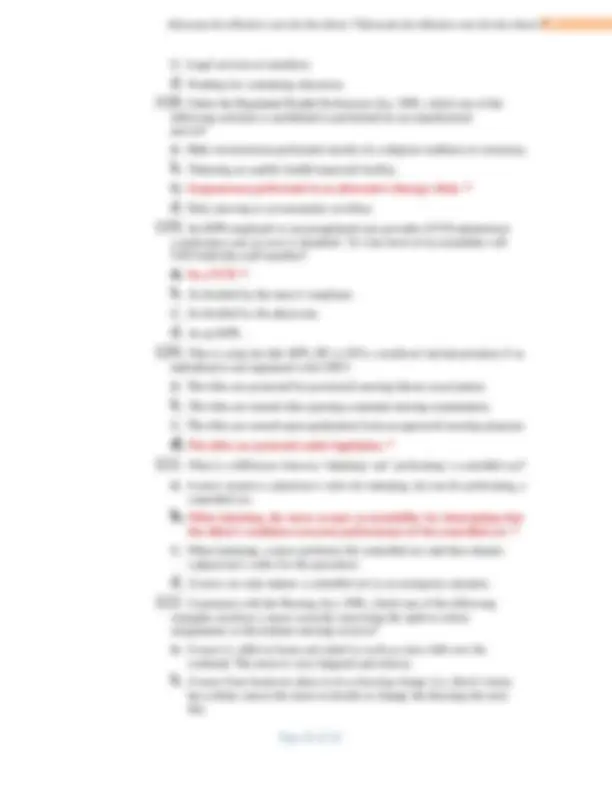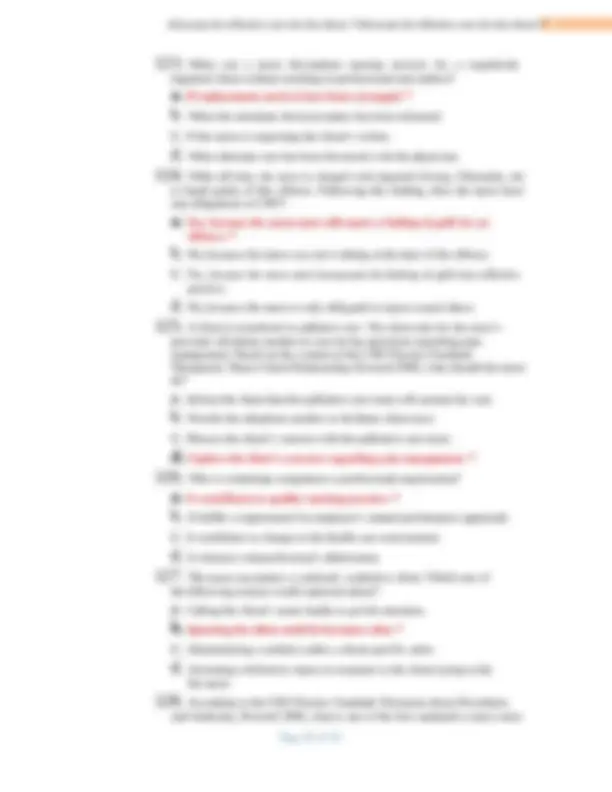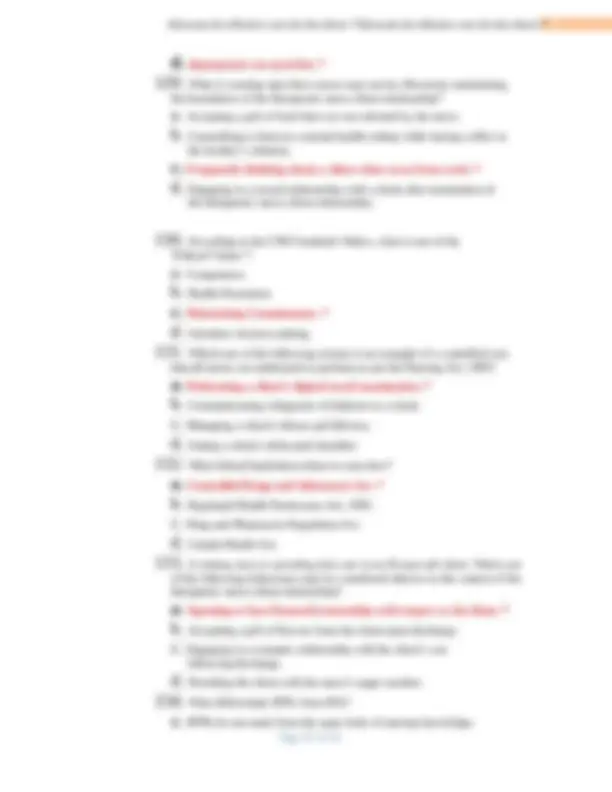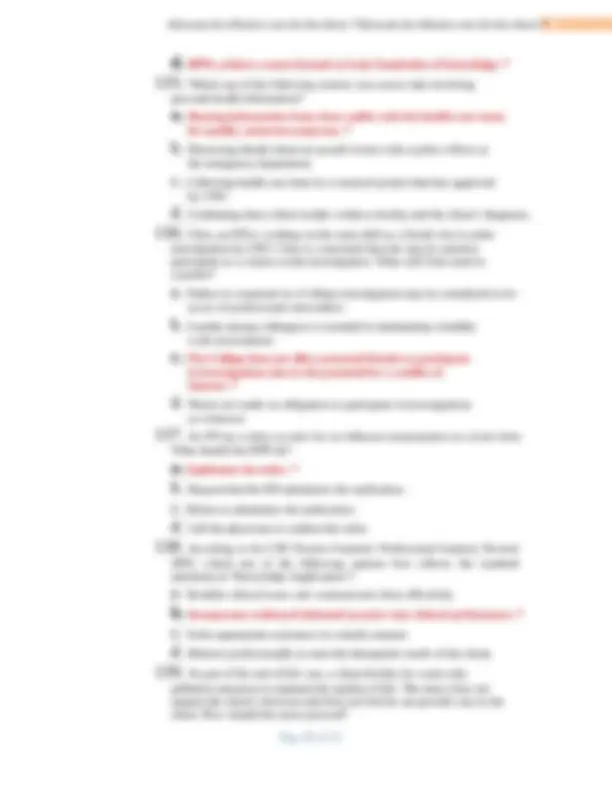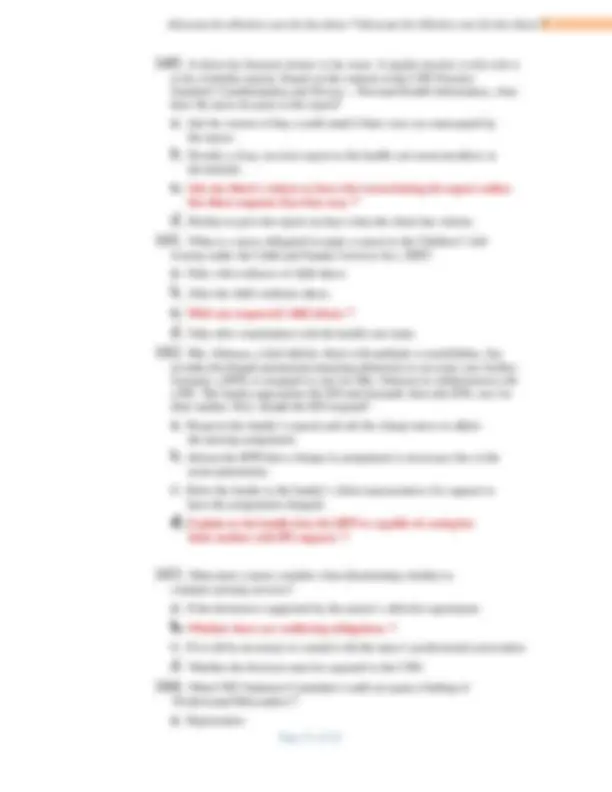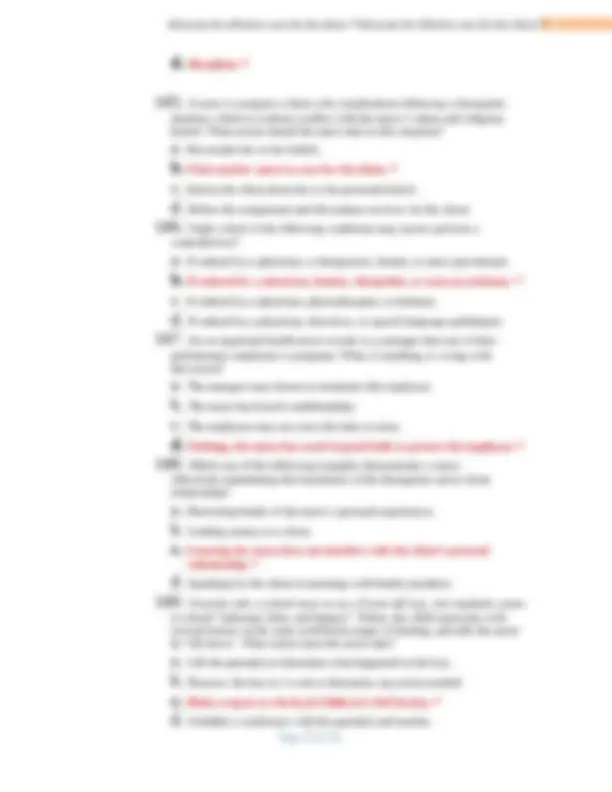Download JURISPRUDENCE EXAM REVIEWER and more Exams Nursing in PDF only on Docsity!
JURISPRUDENCE EXAM
REVIEWER
1. A client requires chemotherapy and radiation. The client agrees to the
treatment on the condition that he receives constant nursing support due to his anxiety. What should the nurse do?
a. Work within the normal staffing parameters.
b. Suggest the client consider hiring a private nurse.
c. Provide the extra care requested by the client.
d. Advocate for effective care for the client. *
2. According to the CNO Practice Standard: Professional Standards Revised
2002, which one of the following descriptions best reflects the Standard Statement related to ‘Accountability’?
a. All nurses are accountable to their clients, their employer and themselves.
b. Each nurse is accountable for providing, facilitating and promoting
the best possible care to the public.
c. Each nurse is accountable to the public and responsible for meeting
**legislative requirements and the standards of the profession. ***
d. All nurses are accountable for possessing, through continuing learning,
knowledge relevant to practice.
3. What must be included for consent to be considered informed?
a. Information the physician determines the client should know.
b. The composition of the health care team.
c. The exact length of time to recover from treatment.
d. Alternative courses of action instead of the proposed treatment. *
4. According to the CNO Practice Standard: Professional Standards, Revised
2002, what is included in the Standard Statement related to ‘Relationships’?
a. Caring and compassionate.
b. Collegial and knowledgeable.
c. Supportive and comprehensive.
d. Therapeutic and professional. *
5. What is one part of the definition of ‘professional misconduct’ as defined by
the Health Professions Procedural Code?
a. Guilty of an offence relevant to the member’s suitability to practice. *
b. Has a physical condition limiting practice.
c. Guilty of a criminal offence under Ontario Law.
d. Has a mental illness that limits the member’s suitability to practice safely.
6. Which one of the following statements describes the Ethical Value related to
11. Which one of the following health care providers is appropriately using
the authorizing mechanism of ‘initiation’?
a. An RN who establishes peripheral venous access in an emergency
**situation. ***
b. An RPN who cleanses, soaks, probes and packs a wound below
the dermis.
c. A PSW who discontinues an intravenous site.
d. An RN who performs an elective cardioversion.
12. A nurse is advocating for a group of clients to obtain government subsidies
for adequate nutrition. According to the CNO Practice Standard: Professional Standards, Revised 2002, which one of the following Standard Statements best describes the nurse’s actions?
a. Relationships.
b. Accountability. *
c. Knowledge.
d. Leadership.
13. A physician gives a nurse a telephone directive to catheterize the physician’s
admitted clients. Why should the nurse refuse to follow this directive?
a. Direct orders must be always written for any procedure and treatment.
b. Nurses can initiate catheterization on in-patients without a directive.
c. Directives must always be written and signed by the physician or NP. *
d. Nurses must always have the act of catheterization delegated.
14. What is the purpose of ‘mandatory reporting’ to CNO?
a. To update CNO regarding address changes.
b. To protect nursing colleagues.
c. To notify CNO of unsafe nursing practice. *
d. To enforce limitations on nurses’ practices.
15. A client expresses a wish to die at home. The nurses’ discusses the client’s
expectations and negotiates a plan of care involving all relevant parties. According to the CNO Practice Standard: Therapeutic Nurse-client relationship, Revised 2006, which Standard Statement does this demonstrate?
a. Therapeutic Communication.
b. Maintaining boundaries.
c. Client-centered care. *
d. Maintaining a Quality Practice setting.
16. Which of the following nursing practices demonstrates client choice?
a. Providing the client with the necessary information for informed
**decision-making. ***
b. Exploring the wishes of the health care team regarding client care.
c. Encouraging the client to choose a specific treatment option.
a. Discuss changing the client’s plan of care with the health care team.
b. Attempt to convince the client’s family that there are other options.
c. Consult with a nursing colleague to clarify the nurse’s own values. *
d. Report the plan of care to the Ethics Review Committee.
18. Which one pf the following options is an example of an
‘authorizing mechanism’?
a. Standing order.
b. Delegation. *
c. Practice guideline.
d. Advance directive.
19. Which one of the following conditions must be met prior to a
nurse ‘initiating’ a controlled act authorized to nurses?
a. There is a directive for the nurse to perform the procedure.
b. The nurse has determined the client’s condition warrants
**performance of the procedure. ***
c. A mechanism exists to support delegation of the procedure.
d. There is a physician’s order for the procedure.
20. Which one of the following statements is true?
a. The Regulated Health Professions Act, 1991 is applicable to all health
care providers.
b. The Nursing Act, 1991 regulates nursing practice; however, the Regulated
health Professions Act, 1991 does not.
c. The Regulated Health Professions Act, 1991 does not have provisions
that are relevant to nursing students.
d. The Regulated Health Professions Act, 1991 and the Nursing
**Act, 1991 both regulate the nursing profession. ***
21. Which one of the following actions by a nurse demonstrates unequal
power in the nurse-client relationship?
a. Administering an antibiotic as ordered.
b. Assisting the client with personal care.
c. Informing a client of a toileting schedule. *
d. Expressing empathy for a client.
22. The nurse has a client who does not speak or understand English or
French. Family members, acting as interpreters, have stated that the client would not want to know his prognosis. What is the nurse’s responsibility in this situation?
a. Respect the wishes of family and do not disclose this information.
b. Encourage the family members to reconsider their situation.
c. Involve a non family member as an interpreter to confirm the client’s
**wishes. ***
a delegated task?
a. When any emergency situation occurs.
b. When an authorizing mechanism is in place.
c. When the activity is not a controlled act.
d. When the nurse has the necessary certification. *
29. According to the CNO Practice Standard: Documentation, Revised 2008,
which one of the following statements best demonstrates appropriate documentation?
a. “Client admitted via stretcher”.
b. “Client states that his roommate had his ‘girlfriend in overnight’.”
c. “Client states his pain is a ‘1 out of 10’.” *
d. “Client is non-adherent to treatment.”
30. Which of the following examples represents sexual abuse as defined by
the Health Professions Procedural Code?
a. A 12-year old client with suspected vaginal trauma.
b. Consensual sexual relations between a nurse and a client. *
c. A female client who discloses unwanted sexual relations with a partner.
d. Unwanted sexual relations between a nurse and a colleague.
31. What is included in the mandatory requirements for nurses who are
randomly selected to participate in CNO’s Quality Assurance Program?
a. Peer assessment. *
b. Client assessment.
c. Health assessment.
d. Workplace assessment.
32. The Consent and capacity Board has found Mr. Silva incapable of making
decisions. His nephew, who is his substitute decision-maker, has given consent to start the application for placement in long-term care. Mr. Silva wishes to stay in his home. According to the Health Care Consent Act, 1996, which one of the following statements is true?
a. Mr. Silva’s nephew has the authority to make the placement decision.
b. Mr. Silva’s consent overrides that of his nephew because they are in
disagreement.
c. Mr. Silva can refuse to leave his home and arrange his own support system
through the Community Care Access Centre.
d. Mr. Silva’s physician has the ability to override the finding of incapacity.
33. What statement best articulates the overall responsibility for all nurses
to practice in accordance with CNO’s standards of practice?
a. Nurses must participate in CNO’s Quality Assurance Program including
creating an annual Learning Plan and obtaining peer input.
b. Nurses must remit their annual registration fee in a timely manner
to maintain their registration.
**Profession and will keep current and competent throughout their nursing careers. ***
34. Which one of the following statements is a key element of informed
consent according to the CNO Practice Guideline: Consent?
a. Age of consent.
b. Power of attorney of personal care.
c. The common law.
d. Alternative courses of action. *
35. According to the CNO Practice Standard: Documentation, Revised 2008,
what is one of the CNO Standard Statements that describes a nurse’s accountability when documenting?
a. Assessment.
b. Professional Practice.
c. Goal orientation.
d. Communication. *
36. How does professional misconduct relate to CNO’s practice standards?
a. Failure to meet any of the practice standards may be
**considered professional misconduct. ***
b. Professional misconduct is only addressed in the CNO Practice
standard: Professional standards, Revised 2002.
c. Professional misconduct is only addressed in the CNO Practice
standard: Therapeutic Nurse-Client Relationship, Revised 2006.
d. Failure to comply with CNO Practice standards is illegal and therefore
is considered professional misconduct.
37. Which one of the following individuals can delegate a controlled act to
a nurse?
a. Paramedic.
b. Dentist. *
c. Physician’s assistant.
d. Diagnostic Sonographer.
38. Which one of the following situations would represent a concern
about exceeding the boundaries of the therapeutic nurse-client relationship?
a. A nurse introduces herself or himself to the client by name and
professional designation.
b. A nurse reveals to the health care team a secret shared by the client that is
relevant to the plan of care.
c. A client asks the nurse to address him by his middle name because
**that is what all his friends call him. ***
d. A client is willing to speak only with his primary nurse and refuses to
speak with other nurses.
b. All the information if the diagnosis is employer-related.
c. No information without consent from the client. *
d. The client’s prognosis, but not the diagnosis.
44. Who may determine capacity for the purpose of the Substitute
Decisions Act, 1992?
a. A trained capacity assessor. *
b. Any physician or social worker.
c. The client’s substitute decision-maker.
d. The office of the Public Guardian and Trustee.
45. A nurse is providing care for a client in the client’s home. After the nurse
provides treatment, the client invites the nurse out for a coffee. How should the nurse respond?
a. Decline the offer and clarify the nurse’s role in the nurse-client
**relationship. ***
b. Accept the offer as it would be beneficial to further develop the
nurse- client relationship.
c. Decline the offer and promptly leave the client’s home.
d. Agree to meet the client for coffee, but only to discuss the therapeutic
care plan.
46. A nurse is overheard saying “Your breasts looks great in that shirt” to a
client. The client smiles and walk away. Is this sexual abuse?
a. No, because sexual contact is not made.
b. No, because the client did not object.
c. Yes, because the comment was of a sexual nature. *
d. Yes, because any unwelcome remark is a form of sexual abuse.
47. Consistent with the Health care Consent Act, 1996, when is a nurse
required to obtain consent for treatment?
a. Providing nursing services to an ill 8-year-old in a community
**health centre. ***
b. Administering blood products to a hemorrhaging client in the
operating room.
c. Performing CPR on an individual who has been found unconscious on
the street.
d. Treating an unconscious client with a head injury in the emergency room.
48. What is the legislation related to the CNO Practice Standards; Restraints?
a. Health care Consent Act, 1996.
b. Patient Restraints Minimization Act, 2001. *
c. Occupational Health and safety Act, 1990.
d. Health Protection and Promotion Act, 1990.
49. Which one of the following circumstances is mandatory for nurses to
c. Work-related discipline.
d. Frequent medication errors.
50. What is one purpose of Nursing Documentation?
a. To limit involvement to legal proceedings.
b. To record every care event experienced by the client.
c. To communicate interventions in care to the health care team. *
d. To protect the practice of colleagues.
51. A nurse has recently relocated and changed employers. What is the nurse’s
responsibility to CNO?
a. Report address changes to CNO when renewing the nurse’s annual
membership.*
b. Advise the nurse’s new employer to fax all changes to CNO.
c. Immediately update any changes to the nurse’s employer or home
address with CNO.
d. Re-register and submit the new information to CNO.
52. A 79-year-old mentally competent client is at high risk for falls. The nurse
recommends the use of a cane or a walker, but the client refuses. What should the nurse do first?
a. Explore other options with the client that may be acceptable. *
b. Request that the physician speak to the client.
c. Call the client’s substitute decision-maker to discuss the matter.
d. Refer the client to a physiotherapist for assessment.
53. What is CNO’s mandate?
a. To develop practice standards.
b. To protect the public interest. *
c. To provide a disciplinary body available to the public.
d. To create entry-to-practice requirements in Ontario.
54. Which one of the following statements represents a component
of therapeutic communication used by nurses?
a. Using terms of endearment when addressing client.
b. Speaking slowly and loudly to all clients to assure they hear
and understand.
c. Modifying their communication style for each client. *
d. Sharing personal information with clients in order to establish trust and
a feeling of intimacy.
55. What is the key piece of legislation that protects the client’s confidentiality?
a. Personal Health Information Protection Act, 2004. *
b. Quality of Care Information Protection Act.

